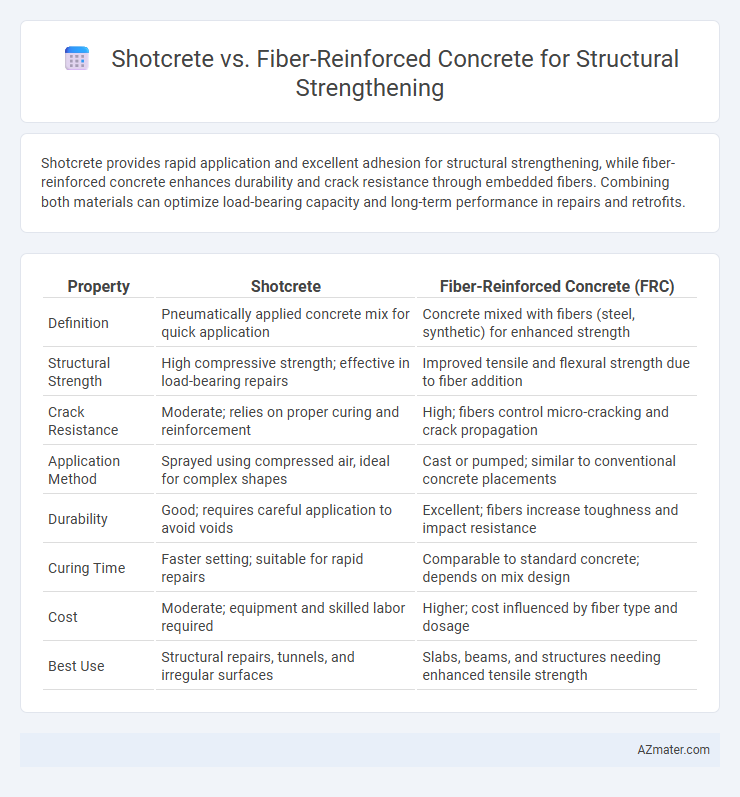Shotcrete provides rapid application and excellent adhesion for structural strengthening, while fiber-reinforced concrete enhances durability and crack resistance through embedded fibers. Combining both materials can optimize load-bearing capacity and long-term performance in repairs and retrofits.
Table of Comparison
| Property | Shotcrete | Fiber-Reinforced Concrete (FRC) |
|---|---|---|
| Definition | Pneumatically applied concrete mix for quick application | Concrete mixed with fibers (steel, synthetic) for enhanced strength |
| Structural Strength | High compressive strength; effective in load-bearing repairs | Improved tensile and flexural strength due to fiber addition |
| Crack Resistance | Moderate; relies on proper curing and reinforcement | High; fibers control micro-cracking and crack propagation |
| Application Method | Sprayed using compressed air, ideal for complex shapes | Cast or pumped; similar to conventional concrete placements |
| Durability | Good; requires careful application to avoid voids | Excellent; fibers increase toughness and impact resistance |
| Curing Time | Faster setting; suitable for rapid repairs | Comparable to standard concrete; depends on mix design |
| Cost | Moderate; equipment and skilled labor required | Higher; cost influenced by fiber type and dosage |
| Best Use | Structural repairs, tunnels, and irregular surfaces | Slabs, beams, and structures needing enhanced tensile strength |
Introduction to Structural Strengthening Methods
Structural strengthening methods enhance the load-bearing capacity and durability of existing structures using materials like shotcrete and fiber-reinforced concrete (FRC). Shotcrete, a pneumatically applied concrete, provides rapid installation and excellent adhesion on complex surfaces, making it ideal for repairs and reinforcement. Fiber-reinforced concrete integrates synthetic or steel fibers to improve tensile strength, crack resistance, and toughness, supporting long-term structural performance.
Overview of Shotcrete Technology
Shotcrete technology involves the pneumatic application of concrete or mortar at high velocity onto a surface, enabling rapid and efficient structural strengthening. This method provides excellent adhesion and compaction, making it ideal for rehabilitating damaged structures and enhancing load-bearing capacity. Shotcrete's versatility allows for reinforcement with fibers or steel to improve tensile strength and durability in various construction and repair projects.
Fundamentals of Fiber-Reinforced Concrete
Fiber-Reinforced Concrete (FRC) enhances structural strengthening by incorporating discrete fibers, such as steel, glass, or synthetic materials, into the concrete matrix to improve tensile strength, ductility, and crack resistance. The fibers bridge cracks that develop under stress, distributing loads more evenly and preventing sudden failure, which is critical in rehabilitation and upgrading of existing structures. Compared to traditional shotcrete, FRC offers superior toughness and durability, making it suitable for applications requiring long-term performance and resilience under dynamic loading conditions.
Comparative Material Properties
Shotcrete exhibits high compressive strength and excellent bond adherence, suitable for rapid application in structural rehabilitation. Fiber-reinforced concrete (FRC) integrates synthetic or steel fibers, significantly enhancing tensile strength, toughness, and crack resistance. Compared to shotcrete, FRC offers improved ductility and fatigue resistance, making it ideal for structures subjected to dynamic loading.
Structural Performance and Load-Bearing Capacity
Shotcrete offers high compressive strength and excellent adhesion to existing structures, enhancing overall structural performance through effective load transfer and crack control. Fiber-reinforced concrete improves tensile strength and ductility by distributing micro-cracks, significantly increasing load-bearing capacity and impact resistance. Combining shotcrete with fiber reinforcement optimizes structural strengthening, delivering superior durability and resilience under dynamic and static loads.
Durability and Long-Term Behavior
Shotcrete offers excellent adhesion and dense compaction, resulting in high initial strength and durability against environmental degradation in structural strengthening applications. Fiber-Reinforced Concrete (FRC) enhances crack resistance and toughness, improving long-term behavior by controlling micro-cracking and reducing maintenance costs. Both materials contribute significantly to durability, but FRC's fibers provide superior resilience under cyclic loading and dynamic stresses over extended periods.
Application Techniques and Construction Efficiency
Shotcrete offers rapid application through pneumatic spraying, making it ideal for complex shapes and overhead surfaces in structural strengthening projects, while fiber-reinforced concrete (FRC) enhances tensile strength and crack resistance by integrating synthetic or steel fibers within the mix, often applied using conventional pouring or pumping methods. Construction efficiency improves with shotcrete by minimizing formwork and excavation time, whereas FRC requires less labor for reinforcement placement and accelerates curing due to improved matrix integrity. Choosing between shotcrete and fiber-reinforced concrete depends on project-specific demands such as surface geometry, load requirements, and desired application speed.
Cost Analysis and Project Economics
Shotcrete offers a cost-effective solution for structural strengthening by reducing labor and formwork expenses through its spray application, while fiber-reinforced concrete (FRC) increases material costs due to specialty fibers but enhances durability and reduces long-term maintenance. Economic evaluation favors shotcrete in small to medium projects with complex geometries where rapid application lowers overall timelines and labor costs. For large-scale or high-stress structures, the increased upfront investment in FRC can yield superior lifecycle cost savings by minimizing crack propagation and improving toughness.
Suitability for Various Structural Projects
Shotcrete offers exceptional adaptability for complex geometries and rapid application on vertical or overhead surfaces, making it highly suitable for tunnel linings, bridge repairs, and thin-shell structures. Fiber-Reinforced Concrete enhances crack resistance and durability in load-bearing elements such as slabs, beams, and pavements, particularly in infrastructure projects requiring improved tensile strength. Selecting between shotcrete and fiber-reinforced concrete depends on project-specific factors like surface accessibility, required structural performance, and environmental exposure conditions.
Conclusion: Selecting the Best Method for Strengthening
Shotcrete offers rapid application and excellent adhesion for complex shapes, making it ideal for urgently rehabilitating deteriorated structures. Fiber-reinforced concrete enhances crack resistance and tensile strength, providing long-term durability and improved load-bearing capacity. Selecting the best method depends on project-specific factors such as structural condition, environmental exposure, and performance requirements, with an emphasis on optimizing structural strengthening outcomes.

Infographic: Shotcrete vs Fiber-Reinforced Concrete for Structural Strengthening
 azmater.com
azmater.com